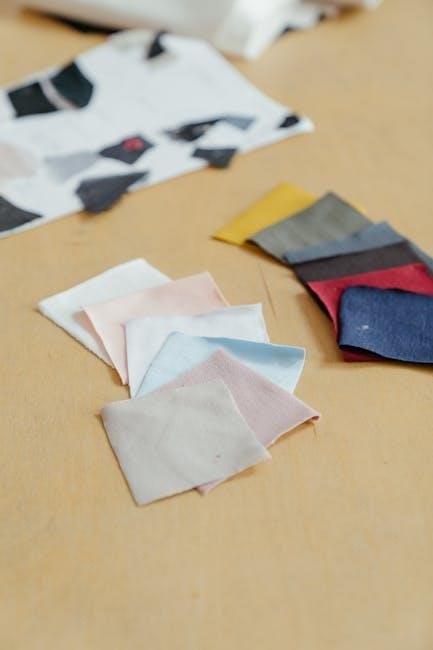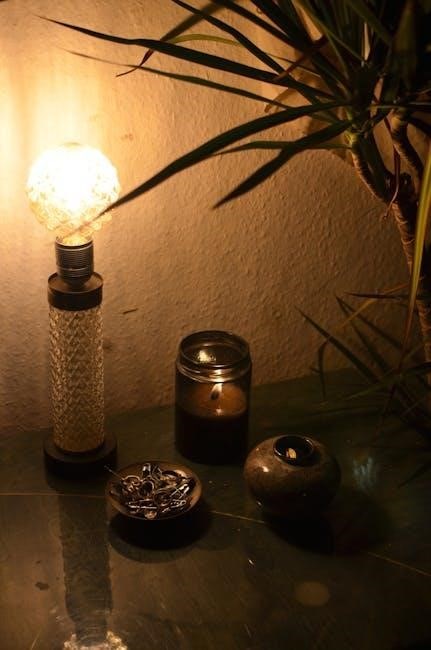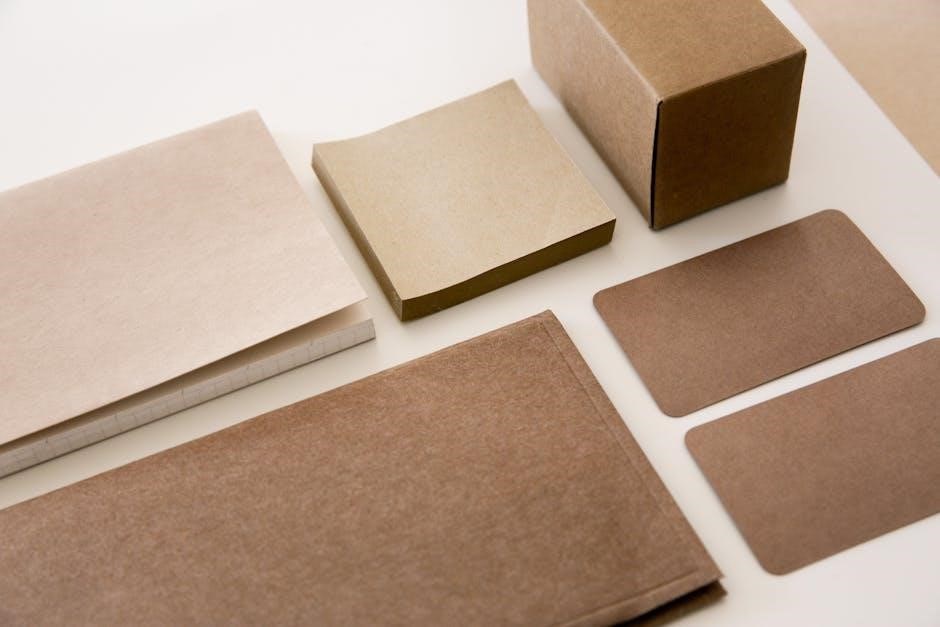The XTool D1 Pro 20W is a versatile laser cutter and engraver designed for hobbyists and professionals․ It supports various materials like wood, metal, and acrylic, with adjustable power and speed settings․ The official material settings PDF guide provides detailed parameters for optimal performance, ensuring precise cuts and engravings while maintaining safety․ This guide is essential for mastering the machine’s capabilities and achieving consistent results across different projects․
Overview of the XTool D1 Pro 20W
The XTool D1 Pro 20W is a high-performance laser cutter and engraver designed for precision and versatility․ With a 20W laser module, it offers enhanced cutting and engraving capabilities for various materials, including wood, metal, and acrylic․ Its compact design and user-friendly interface make it ideal for both hobbyists and professionals․ The machine features a 340x390mm working area, allowing for efficient processing of medium-sized projects․ The XTool D1 Pro 20W is known for its reliability and consistency, delivering professional-grade results with minimal setup․ Its compatibility with LightBurn and other software platforms further enhances its functionality, enabling users to customize settings for optimal performance․
Importance of Material Settings for Laser Cutting and Engraving
Material settings are crucial for achieving optimal results in laser cutting and engraving․ Different materials respond uniquely to laser energy, making precise power, speed, and focus adjustments essential․ Incorrect settings can lead to inefficient cuts, damaged materials, or even safety hazards․ The XTool D1 Pro 20W’s performance heavily depends on these parameters, as each material type has specific requirements for power output and processing speed․ For instance, denser materials like hardwood may require higher power and slower speeds, while delicate materials such as acrylic need careful calibration to prevent melting or discoloration․ Proper material settings ensure safety, reduce waste, and enhance the quality of the final product, making them a cornerstone of successful laser operations․

Key Considerations for Material Settings
Material type, thickness, and required power/speed are critical factors․ The official XTool D1 Pro 20W material settings PDF provides precise parameters for optimal cutting and engraving results․
Understanding Power, Speed, and Focus Settings
Power, speed, and focus are fundamental parameters for laser cutting and engraving․ The XTool D1 Pro 20W material settings PDF outlines specific values for each material, ensuring precise results․ For example, basswood plywood requires 50% power and 60 mm/s speed for cutting, while metal settings vary significantly․ Adjusting focus ensures the laser beam hits the material accurately, critical for clean cuts․ Incorrect settings can lead to incomplete cuts or material damage․ Testing these parameters before final processing is essential to avoid waste and achieve desired outcomes․ Proper calibration and adherence to the PDF guide help users optimize their workflow and maintain consistent quality across projects․

Why Material-Specific Settings Are Crucial
Material-specific settings are vital for achieving optimal results with the XTool D1 Pro 20W․ Each material reacts differently to laser energy, requiring unique power, speed, and focus adjustments․ For instance, wood and acrylic have distinct thresholds for cutting and engraving․ Using the wrong settings can result in incomplete cuts, burns, or damage to the material․ The material settings PDF guide provides tailored parameters, ensuring efficiency and safety․ By following these guidelines, users can prevent wasted materials and time, while also extending the lifespan of their laser module․ Customizing settings for each material ensures consistent quality and precision in every project․
Testing Settings Before Final Processing
Testing settings before final processing is essential to ensure accurate results and prevent material waste․ The XTool D1 Pro 20W allows users to perform test runs on small material samples to refine power, speed, and focus settings․ This step helps identify any mismatches between the selected parameters and the material’s properties․ By engraving or cutting a small area first, users can verify the output and make necessary adjustments․ The official material settings PDF guide provides baseline recommendations, but real-world conditions may vary․ Testing ensures that the final output meets expectations, whether cutting through thick wood or engraving delicate acrylic․ It also minimizes the risk of damaging the material or the laser module, making it a critical step in the workflow․

Material-Specific Settings for the XTool D1 Pro 20W
The XTool D1 Pro 20W offers tailored settings for various materials, ensuring precise cuts and engravings․ The official material settings PDF guide provides detailed parameters for wood, metal, acrylic, and other materials, optimizing performance and safety․
Wood Settings (Basswood, Birch, Cherry, Mahogany, Pine Plywood)
The XTool D1 Pro 20W supports various wood types, each requiring specific settings for optimal results․ Basswood, Birch, Cherry, Mahogany, and Pine Plywood have distinct thickness and density levels, affecting power and speed․ The material settings PDF guide provides detailed parameters, ensuring precise cuts and engravings․ For example, Basswood plywood may require lower power settings due to its softness, while denser woods like Mahogany might need higher power․ Testing small areas first is recommended to avoid waste․ Adjustments in focus length and laser intensity are crucial for achieving clean cuts․ Proper settings prevent burning or incomplete cuts, ensuring high-quality finishes․ Always refer to the guide for tailored recommendations based on material thickness and type․
Metal Settings (Including Stainless Steel and Aluminum)
Metal settings for the XTool D1 Pro 20W require precise adjustments due to the hardness and conductivity of materials like stainless steel and aluminum․ The material settings PDF guide provides optimized parameters for cutting and engraving metals, ensuring safe and effective processing․ Higher power levels are typically needed for metals, with slower speeds to maintain focus and prevent damage; Focus length adjustments are critical to achieve sharp, clean cuts․ Testing on small areas is recommended to avoid waste․ The guide also highlights safety considerations, such as proper ventilation for metal fumes․ By following the recommended settings, users can achieve professional-grade results for metal projects, from intricate engravings to precise cuts․
Acrylic Settings for Cutting and Engraving
Acrylic settings for the XTool D1 Pro 20W require careful balancing of power and speed to achieve smooth cuts and detailed engravings․ For cutting, higher power levels (typically 80-100%) and slower speeds (50-80 mm/min) are recommended to ensure clean edges․ Engraving, however, often uses lower power (30-50%) and faster speeds (100-150 mm/min) to prevent melting or discoloration․ Focus adjustments are critical, with the focal length optimized for the material’s thickness․ The material settings PDF guide provides specific parameters for various acrylic thicknesses and finishes․ Testing on scrap material is advised to refine settings and avoid waste․ Proper ventilation is essential, as acrylic cutting releases fumes․ By following these guidelines, users can achieve professional-quality acrylic cuts and engravings with the XTool D1 Pro 20W․
Other Materials (Leather, Fabric, Plastic, etc․)
For materials like leather, fabric, and plastic, the XTool D1 Pro 20W offers versatile settings to ensure precise results․ Leather typically requires lower power (40-60%) to avoid burning, while fabric may need reduced speed (50-80 mm/min) to prevent fraying․ Plastic settings vary by type but often involve moderate power (50-70%) and controlled speed to prevent melting․ The material settings PDF guide provides tailored parameters for these materials, optimizing cuts and engravings․ Testing on scrap material is crucial to refine settings and avoid waste․ Additionally, materials like foam or thin plastics may require specific focus adjustments․ Users should always ensure proper ventilation, especially with materials that release fumes during processing․ By following the guide, users can achieve excellent results with these diverse materials․ Regular maintenance of the laser module is also essential for consistent performance․

Optimizing Settings for Different Projects
Adjust power levels for material thickness, reduce speed for detailed engravings, and fine-tune focus height for precise cuts․ These optimizations ensure superior results across various projects․

Adjusting Power Levels for Various Thicknesses
Adjusting power levels is crucial for achieving optimal results with the XTool D1 Pro 20W․ For thicker materials, higher power settings are necessary to ensure clean cuts, while thinner materials require lower power to prevent burning or damage․ The official PDF guide provides detailed recommendations, such as using 20% power for thin acrylic and up to 80% for dense wood․ It’s important to test settings on scrap material first to avoid waste․ Additionally, the machine allows real-time adjustments, enabling users to fine-tune power levels based on material response․ This customization ensures precision and consistency across all projects․
Speed Adjustments for Detailed Engraving
Speed adjustments play a key role in achieving precise and detailed engravings with the XTool D1 Pro 20W․ Slower speeds are typically recommended for intricate designs to ensure clarity and accuracy, while faster speeds are suitable for broader strokes or less detailed work․ The official PDF guide provides specific speed parameters for materials like wood, metal, and acrylic, helping users optimize their settings․ For example, reducing speed by 10-20% can enhance detail retention in complex patterns․ Testing on scrap material is essential to find the perfect balance between speed and detail․ Proper speed adjustments ensure that engravings are crisp and free from unwanted marks, making it easier to achieve professional-quality results consistently․
Focal Length and Height Adjustments
Focal length and height adjustments are crucial for precise cutting and engraving with the XTool D1 Pro 20W․ The machine’s laser module requires proper alignment to ensure the beam focuses accurately on the material․ According to the official PDF guide, adjusting the focal length involves setting the correct distance between the laser and the workpiece, typically around 1-2mm․ Height adjustments ensure the laser is positioned correctly for different material thicknesses․ Incorrect focus can lead to uneven cuts or burns․ The guide recommends testing focal settings on scrap material before processing final pieces․ Proper adjustments enhance performance, ensuring clean cuts and detailed engravings․ Regular calibration is also advised to maintain optimal results and extend the laser module’s lifespan․ This attention to detail guarantees consistent quality in various projects․
Using the XTool D1 Pro 20W Material Settings PDF Guide

The official PDF guide provides detailed material-specific settings for the XTool D1 Pro 20W, ensuring optimal performance․ It includes power, speed, and focus parameters for various materials, helping users achieve precise cuts and engravings․ The guide also offers troubleshooting tips and safety recommendations, making it an essential resource for mastering the machine․ By following the guide, users can minimize waste and ensure consistent results across different projects․ Regular updates and customization options are also highlighted, allowing for tailored settings based on specific needs․ This comprehensive resource is indispensable for both beginners and experienced users․
Navigating the Official Material Parameters Reference
The official XTool D1 Pro 20W material settings PDF guide is organized into clear sections, making it easy to navigate․ Users can find specific material categories, such as wood, metal, and acrylic, each with detailed parameters․ The guide includes power, speed, and focus settings tailored for different materials, ensuring optimal results․ Tabs or sections are labeled clearly, allowing quick access to relevant information․ For example, wood settings include options for basswood, birch, and mahogany, with specific power levels and speeds recommended․ Testing settings before final processing is emphasized to avoid material waste․ Additionally, the guide provides tips for adjusting parameters based on material thickness and desired outcomes․ This resource is indispensable for achieving precise cuts and engravings, and it complements the material settings PDF perfectly․
How to Apply Recommended Settings in Software
To apply the recommended settings from the XTool D1 Pro 20W material settings PDF in the software, start by accessing the material library․ Create or modify profiles for each material, such as basswood or acrylic, by inputting the suggested power levels, speed settings, and focus adjustments․ Ensure the software uses the same units as the PDF for consistency․ Adjust the focus settings separately or within the material profile as needed․ Conduct test runs on scrap material to fine-tune settings for optimal results․ For user-defined materials, create new profiles from scratch or base them on existing ones․ Select the appropriate material profile for each project to avoid using incorrect settings․ Adjust settings as needed based on machine performance and save profiles for future use․ Utilize built-in software documentation for guidance and ensure projects are saved with their respective material profiles for consistency․
Customizing Settings for User-Defined Materials
Customizing settings for user-defined materials on the XTool D1 Pro 20W requires careful testing and adjustment․ Begin by selecting a base material profile from the PDF guide that closely matches your material․ Adjust the power, speed, and focus settings incrementally, conducting small-scale tests to evaluate performance․ Use the trial-and-error method to refine settings, ensuring optimal cutting or engraving results without damaging the material․ Maintain detailed records of each adjustment for future reference․ If the material is significantly different from standard options, create a new profile from scratch․ Always verify the machine’s compatibility with the material before proceeding․ This approach ensures safety and efficiency while working with unique or custom materials․ Regularly update your profiles as needed to maintain consistency across projects and materials․
Troubleshooting Common Issues
Inconsistent cutting or engraving results often stem from incorrect power, speed, or focus settings․ Refer to the material settings PDF guide to identify and resolve issues effectively through testing and adjustment․
Addressing Inconsistent Cutting or Engraving Results
Inconsistent results often arise from incorrect power, speed, or focus settings․ To resolve this, consult the XTool D1 Pro 20W material settings PDF guide for recommended parameters․ Test settings on scrap material to ensure accuracy․ If issues persist, check the laser focus alignment and adjust the focal length․ Incorrect material thickness settings can also cause problems, so verify dimensions before processing․ Additionally, ensure the laser module is clean and properly maintained․ For user-defined materials, avoid default settings and manually adjust power levels․ Finally, run test engravings on the material to fine-tune settings before proceeding with the final project․ This approach minimizes waste and ensures consistent outcomes․
Fixing Power and Speed Mismatch
A power and speed mismatch can lead to inadequate cuts or engravings․ To fix this, refer to the XTool D1 Pro 20W material settings PDF guide for precise parameters․ Start by adjusting the laser’s power output according to the material’s thickness and type․ Next, fine-tune the speed setting to ensure proper interaction between the laser and the material․ Test these adjustments on scrap material to verify effectiveness․ If cutting is inconsistent, incrementally increase power or decrease speed․ For engraving, lower power and slower speeds often yield better results․ Always ensure settings align with the material’s properties, as specified in the guide․ Regularly cleaning the laser module and maintaining focus height can also prevent power-speed mismatches․ This method ensures optimal performance and minimizes material waste․
Solving Focus-Related Problems

Focus-related issues are common in laser cutting and engraving․ To address this, ensure the laser module’s focal length is correctly set for the material’s thickness․ Refer to the XTool D1 Pro 20W material settings PDF guide for recommended focal heights․ Use the machine’s autofocus feature or manually adjust the laser head to achieve proper focus․ Test the focus on scrap material by engraving or cutting a small area․ If the beam is inconsistent, check the lens for cleanliness and alignment․ Adjustments may be needed for different materials to maintain precise cutting or engraving․ Proper focus ensures even results and prevents damage to the laser module or material․ Regular calibration and testing are essential for optimal performance․ Always verify focus settings before starting a project to avoid rework․

Safety and Best Practices
Always wear protective goggles and ensure proper ventilation when using the XTool D1 Pro 20W․ Test material settings on scrap before cutting to prevent waste and hazards․ Refer to the material settings PDF guide for safe operating parameters and maintain a clean workspace to avoid accidents․
Ensuring Safe Operation with Different Materials
Operating the XTool D1 Pro 20W safely requires understanding material-specific hazards․ Always wear protective eyewear and ensure proper ventilation to avoid inhaling fumes․ Use the material settings PDF guide to identify suitable power and speed settings, as incorrect parameters can cause fires or damage․ For flammable materials like wood, keep a fire extinguisher nearby․ When working with metals, ensure they are laser-safe and avoid reflective surfaces․ Acrylics and plastics may emit toxic fumes, so ventilation is crucial․ Testing settings on scrap material first helps prevent accidents․ Regularly clean the machine and maintain the laser module for optimal performance and safety․ Adhering to these practices ensures a safe and efficient workflow․
Preventing Material Waste Through Proper Testing
Preventing material waste when using the XTool D1 Pro 20W laser cutter involves a combination of proper preparation and systematic testing․ Start by consulting the material settings PDF guide to obtain baseline settings for your specific material, such as wood or acrylic․ However, recognize that material variations, like density differences in wood, may require adjustments․ Conduct preliminary tests on scrap material to evaluate how the laser interacts with the material under recommended settings․ Observe the results and adjust power, speed, or focus as needed to achieve optimal cuts or engravings․ Document these adjustments for future reference, reducing the need for repeated testing and conserving materials․ Consider material thickness, as thicker materials may necessitate higher power or lower speed settings․ Additionally, utilize software features in programs like LightBurn to run small test engravings or cuts, saving both time and material․ Regular maintenance of the laser module ensures consistent performance, further preventing waste․ By following these steps, you can minimize material waste while ensuring safety and efficiency in your projects․
Maintaining the Laser Module for Optimal Performance
Maintaining the laser module of the XTool D1 Pro 20W is crucial for consistent and high-quality results․ Regularly clean the laser lens to ensure clear beam transmission, preventing dust or debris from affecting performance․ Store the module in a dry, cool environment to avoid moisture damage․ Check the focus alignment periodically and recalibrate if necessary, as misalignment can lead to inaccurate cuts or engravings․ Additionally, inspect the laser diode for wear and ensure proper cooling to prevent overheating, which can degrade performance over time․ Proper maintenance extends the module’s lifespan and ensures reliable operation for various materials․ Always refer to the official material settings PDF guide for specific care instructions tailored to your setup․ Neglecting maintenance can lead to suboptimal cutting and engraving results, making routine checks essential for optimal performance․
The XTool D1 Pro 20W laser cutter is a powerful tool for precise cutting and engraving․ By mastering its settings and experimenting with materials, users unlock its full creative potential․

Final Thoughts on Mastering XTool D1 Pro 20W Settings
Mastering the XTool D1 Pro 20W settings is key to unlocking its full potential․ By understanding and adjusting power, speed, and focus, users can achieve precise cuts and engravings․ The provided PDF guide serves as an invaluable resource, offering material-specific parameters that enhance productivity․ Experimentation and testing are encouraged to refine settings for unique materials․ Regular maintenance and adherence to safety protocols ensure optimal performance․ With practice and exploration, users can leverage the D1 Pro 20W to create intricate designs across various materials, making it an essential tool for both hobbyists and professionals in laser cutting and engraving․
Encouragement to Experiment and Share Results
Experimentation is a cornerstone of mastering the XTool D1 Pro 20W․ Users are encouraged to explore beyond the PDF guide, testing unique materials and settings to discover new creative possibilities․ Sharing results online fosters a sense of community, allowing others to learn and grow․ By documenting and showcasing projects, enthusiasts can inspire innovation and receive feedback․ This collaborative approach not only enhances individual skills but also contributes to the evolution of laser cutting and engraving techniques․ Embrace curiosity, push boundaries, and share your journey to help others unlock the full potential of the XTool D1 Pro 20W․
